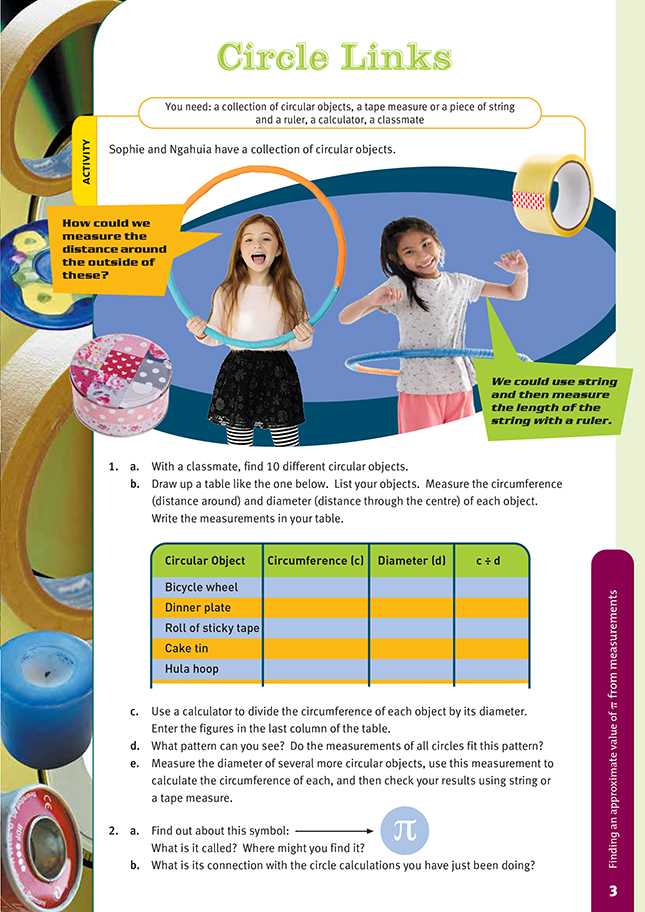Circle Links
This is a level 4 and 5 measurement strand activity from the Figure It Out series.
A PDF of the student activity is included.
Click on the image to enlarge it. Click again to close. Download PDF (452 KB)
find approximate value of pi from measurement
a tape measure, or a piece of string and a ruler
a collection of circular objects
calculator
FIO, Level 4, Measurement, Book One, Circle Links, page 3
classmate
This activity is designed to help students find the relationship between the circumference and the diameter of a circle. This relationship, a constant (the same for all circles, regardless of size), is known as π (pi), a letter of the Greek alphabet.
By measuring a number of different-sized circular objects and using a calculator to divide the circumference of each by its diameter, the students should discover that each time they get a value of 3.14 or closer. 3.14 is the standard approximation (3 significant figures) for π.
What students will not realise without help is that π is an irrational number. Indeed, most will not know that there are such things as irrational numbers. It is worth getting your students to spend some time exploring this new idea. Some facts:
- The exact value of an irrational number can never be written down.
- An irrational number cannot be written as a fraction (such as 3/4 or 5/11).
- When written as a decimal, an irrational number is never complete.
- When an irrational number is written as a decimal, there is no pattern to the sequence of the digits.
- The number of irrational numbers is unlimited. The set of irrational numbers includes √2, √3, and the square root of every other prime number, most roots, the special constants e and , and so on.)
Your students can easily demonstrate, using a calculator, that any fraction they choose is not an irrational number. Here are some examples, using a calculator with a 10-digit display:
- 2/3 = 0.66666666 (The sequence of the digits follows a pattern.)
- 7/8 = 0.875 (The sequence of digits is complete, finite.)
- 6/11 = 0.545454545 (The sequence of the digits follows a pattern.)
- 5/12 = 0.416666666 (The sequence of the digits follows a pattern.)
Where the bottom value (denominator) of a fraction is a larger number, the repeating sequence will not necessarily become apparent within the 10-digit frame. For example: 5/23 = 0.217391304. In such cases, the students could use a calculator with a larger display, or a computer.
The discovery of irrational numbers (credited to Pythagoras) split the Greek mathematical community of the day. It challenged their belief in the absolute orderliness of mathematics. Interested students could investigate this further using the Internet. There are also sites devoted to the wonders of π itself.
Answers to Activity
1. a. Collections will vary.
b. Measurements will vary.
c. Answers will vary, but they should be close to 3.14.
d. The circumference divided by the diameter should give a result of approximately 3.14. This is true for any circular object.
e. Practical activity. Results should all be close to 3.14.
2. a. The symbol is called pi. You can find it on all scientific calculators. It appears in all formulae relating to circles.
b. It is the value you get whenever you divide the circumference of a circle by its diameter.
